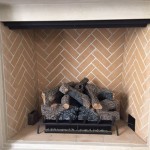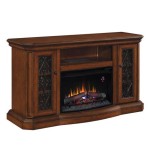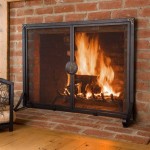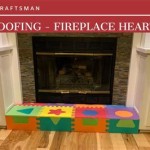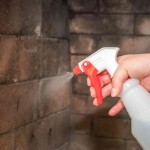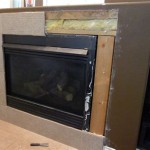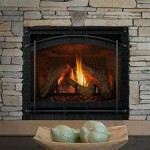Glass Door Fireplace Efficiency: Understanding the Benefits and Challenges
Fireplaces have long been valued for their aesthetic appeal and potential to provide supplemental heating. However, traditional open fireplaces are notoriously inefficient, with a significant portion of the heat generated escaping up the chimney. Glass door fireplace enclosures are often touted as a solution to improve efficiency and overall performance. This article examines the multifaceted topic of glass door fireplace efficiency, exploring the mechanisms by which they function, their advantages and disadvantages, and crucial factors to consider for optimal performance.
A glass door fireplace enclosure fundamentally aims to control airflow and reduce the amount of heated air lost through the chimney. Traditional open fireplaces continuously draw air from the room to fuel the fire, leading to a significant draft. This draft not only consumes the heat produced by the fire itself, but also pulls heated air from other parts of the house, replacing it with colder air from outside. Glass doors, when closed, create a barrier that restricts this airflow, potentially reducing the rate at which heated air is drawn from the room and exhausted up the chimney.
It is important to distinguish between different types of glass door fireplace enclosures. Some are designed primarily for aesthetic purposes, offering limited impact on efficiency. Others, however, are specifically engineered to improve heat retention and combustion. Furthermore, the effectiveness of glass doors is also heavily dependent on installation quality, maintenance practices, and the overall design and condition of the fireplace and chimney.
Key Point 1: Mechanisms of Heat Retention and Reduced Airflow
The primary mechanism by which glass doors contribute to improved fireplace efficiency is through the reduction of radiant heat loss and the control of airflow. An open fireplace radiates heat in all directions, including up the chimney. Glass doors, particularly those with insulated glass or tight seals, can reflect a portion of this radiant heat back into the room, increasing the amount of usable heat output. This reflective property can be further enhanced by features such as heat-resistant coatings applied to the glass surface.
The control of airflow is perhaps the most significant factor influencing efficiency. By restricting the amount of air entering the firebox, glass doors limit the chimney draft. This reduces the rate at which heated air is drawn from the room and lost up the chimney. However, complete restriction of airflow is not desirable, as the fire requires oxygen for combustion. A balance must be achieved, allowing sufficient airflow for efficient burning while minimizing excess draft. Many glass door enclosures incorporate adjustable vents or dampers that allow for fine-tuning of airflow based on specific burning conditions.
The effectiveness of these airflow modifications depends heavily on the design and construction of the chimney itself. A chimney that is too large or has excessive leaks will continue to draw air even with the glass doors closed. Conversely, a chimney that is too small may not provide adequate draft, leading to poor combustion and the buildup of smoke in the room. Proper sizing and maintenance of the chimney are therefore critical for maximizing the efficiency benefits of glass doors.
Furthermore, the seal between the glass doors and the fireplace opening is crucial. Gaps or cracks in the seal will allow air to leak around the doors, negating much of the airflow control benefits. High-quality glass doors often incorporate gaskets or other sealing materials to ensure a tight fit. Regular inspection and maintenance of these seals are essential to maintain their effectiveness.
Key Point 2: Addressing Concerns and Potential Drawbacks
While glass doors offer potential improvements in fireplace efficiency, it is crucial to acknowledge their potential drawbacks and address common concerns. One significant concern is the potential for overheating of the firebox and chimney. By restricting airflow, glass doors can cause the fire to burn hotter and more intensely, potentially leading to excessive temperatures within the firebox and chimney. This can increase the risk of creosote buildup, a flammable substance that can lead to chimney fires. Regular chimney cleaning and inspection are therefore even more critical when using glass doors.
Another concern is the potential for reduced air quality within the home. While glass doors can reduce the overall amount of air drawn from the room, they can also trap smoke and combustion byproducts within the firebox if the chimney draft is insufficient. This can lead to the release of these pollutants into the room when the doors are opened, potentially impacting indoor air quality. Properly sized and maintained chimneys are essential for mitigating this risk.
The choice of wood is also a crucial factor. Burning wet or unseasoned wood produces more smoke and creosote, exacerbating the potential for air quality problems and chimney fires. Using dry, seasoned hardwood is essential for efficient and safe burning, regardless of whether glass doors are installed.
The aesthetic impact of glass doors is another consideration. While some homeowners find glass doors to be aesthetically pleasing, others may prefer the traditional look of an open fireplace. The choice is ultimately a matter of personal preference. However, it is important to select glass doors that are compatible with the style of the fireplace and the overall décor of the room.
The cost of glass doors is also a factor to consider. High-quality glass doors can be a significant investment, and the savings in fuel costs may not always offset the initial expense. A careful cost-benefit analysis is recommended before purchasing glass doors, taking into account the frequency of fireplace use, the cost of fuel, and the potential for improved heat output.
Key Point 3: Factors Influencing Overall Efficiency and Performance
Several factors influence the overall efficiency and performance of a glass door fireplace system. These factors extend beyond the glass doors themselves and encompass the entire fireplace and chimney system. The design and construction of the firebox itself play a significant role. Fireboxes with insulated firebricks or refractory panels can retain heat more effectively, increasing overall efficiency.
The size and type of the chimney are also critical. As previously mentioned, a chimney that is too large or has excessive leaks will negate many of the benefits of glass doors. Conversely, a chimney that is too small may not provide adequate draft, leading to poor combustion and the buildup of smoke. Selecting the appropriate chimney liner materials can also improve efficiency and safety. Stainless steel liners, for example, are more durable and resistant to corrosion than traditional clay liners.
Proper installation of the glass doors is essential for optimal performance. The doors must fit snugly against the fireplace opening to create a tight seal. Gaps or cracks will allow air to leak around the doors, reducing their effectiveness. Professional installation is recommended to ensure a proper fit and seal.
Regular maintenance is also crucial. The glass doors should be cleaned regularly to remove soot and creosote buildup, which can reduce their ability to radiate heat. The seals around the doors should be inspected regularly and replaced as needed to maintain a tight fit. The chimney should be inspected and cleaned annually to prevent creosote buildup and ensure proper draft.
Finally, user behavior plays a significant role. Burning dry, seasoned wood, adjusting the airflow controls appropriately, and avoiding overloading the firebox are all important practices for maximizing efficiency and minimizing the risk of problems. Education and awareness of proper burning techniques are essential for ensuring safe and efficient fireplace operation.
In summary, the efficiency of glass door fireplaces is a complex issue influenced by a variety of factors. While glass doors can potentially improve heat retention and reduce airflow, their effectiveness depends on the design and construction of the fireplace and chimney, proper installation and maintenance, and user behavior. A comprehensive understanding of these factors is essential for making informed decisions and maximizing the benefits of glass door fireplace enclosures.

The Value Of Glass Doors For Your Fireplace Royal Oak Mi

Fireplace Glass Doors Vs Screens Full Service Chimney

Should I Put Glass Doors On My Masonry Fireplace

Why You Need Glass Doors On Your Fireplace

Benefits Of Glass Doors Fireplace Door Sets Burlington Wi

5 Big Reasons You Need Fireplace Doors Helpful Advice

5 Reasons You Need Fireplace Doors Stoll Industries

5 Big Reasons You Need Fireplace Doors Helpful Advice

Fireplace Glass Doors Vs Screens Full Service Chimney

How Efficient Is A Fireplace With Glass Doors Dreifuss Fireplaces
Related Posts

